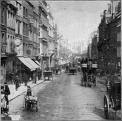Samuel Highley 1803 - 1865
May 16, 2009
 Samuel Highley Junior 1803? - 1865?
was a Medical publisher who was responsible for publishing The British
Homeopathic
Journal,
and all of the major homeopathic publications in Britain from the 1820s
until 1853, when he suddenly announced that henceforth, the publishing
firm of Highley and
Son
would no longer produce any books that mention
homeopathy (John
James
Drysdale, Robert
Ellis
Dudgeon, John
Rutherford
Russell, Richard
Hughes (Eds.), The
British Journal of Homeopathy, Volume
11, (Maclachlan,
Stewart, & Co., 1853). Page 132).
Samuel Highley Junior 1803? - 1865?
was a Medical publisher who was responsible for publishing The British
Homeopathic
Journal,
and all of the major homeopathic publications in Britain from the 1820s
until 1853, when he suddenly announced that henceforth, the publishing
firm of Highley and
Son
would no longer produce any books that mention
homeopathy (John
James
Drysdale, Robert
Ellis
Dudgeon, John
Rutherford
Russell, Richard
Hughes (Eds.), The
British Journal of Homeopathy, Volume
11, (Maclachlan,
Stewart, & Co., 1853). Page 132).
Highley and Son Medical Publishers. Samuel Highley’s father was a medical publisher who worked with John Samuel Murray until 1803, when Samuel Highley senior took all the medical books and medical business, leaving John Samuel Murray to pursue the literary publications.
Samuel Highley junior was also a medical bookseller, who after 1831 carried on the business from 174 Fleet Street and in Webb Street. In 1849, Highley and Son were the publishers of The British Homeopathic Journal.
In 1851, Highley and Son were successful medical publishers at 32 Fleet Street.
In 1853, Highley and Son published Joseph Kidd’s Homeopathy in Acute Diseases: Narrative of a Mission to Ireland, an account of the Famine in Ireland, and the series of papers issued from the English Homeopathic Association, and Marmaduke Blake Sampson’s Truths and Their Reception, Considered in Relation to the Doctrine of Homeopathy, and Robert Ellis Dudgeon’s Pathogenetic Cyclopaedia, and many other homeopathic publications.
In 1853, Highley and Son announced that henceforth, they would not longer produce any books that mention homeopathy. Samuel Highley junior refused to publish any works on homeopathy after this date,
Of interest:
John Samuel Murray 1778
- 1843
John Murray II was an influential publisher during the Romantic period and the second in the long line of the Murray publishing dynasty. He is chiefly remembered for his association with Lord Byron, although he published several other famous authors, including Jane Austen and Washington Irving.
He was also publisher of the eventually infamous Quarterly Review, the Tory rival to the Whig Edinburgh Review.
Murray is finally being recognised as a figure of real importance…
Murray was clearly dissatisfied at the prospects of the business under Samuel Highley senior, and it was inevitable that the partnership would fail. Although they continued to work together for four years, Murray’s relationship with Samuel Highley senior quickly disintegrated and he wrote to his colleague proposing an immediate dissolution of their partnership.
After arbitration, Samuel Highley senior received the estimated cash value of his share of the business and Murray was left with the stock and premises at Fleet Street…
Murray’s letters of this period display his relief at his new found freedom: “I have been shackled to a drone of a partner; but the day of emancipation is at hand. On the twenty fifth of this month [March 1803] I plunge alone into the depths of literary speculation. I am therefore honestly ambitious that my first appearance before the public should be such as will at once stamp my character and respectability.”